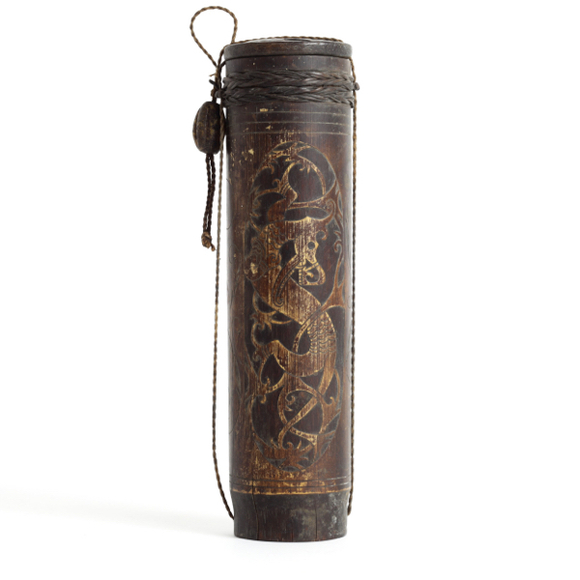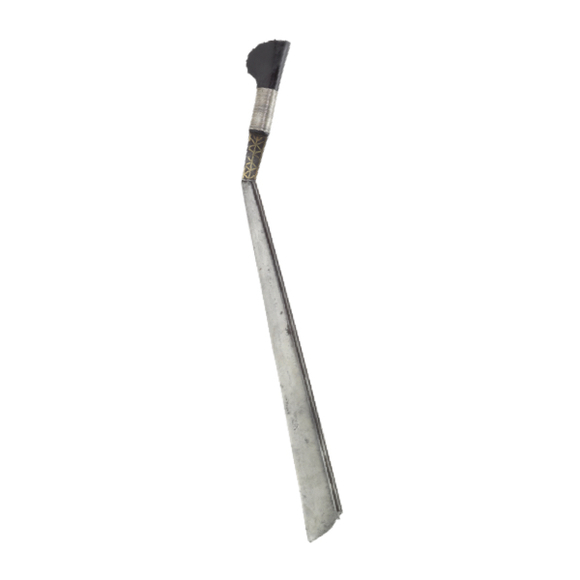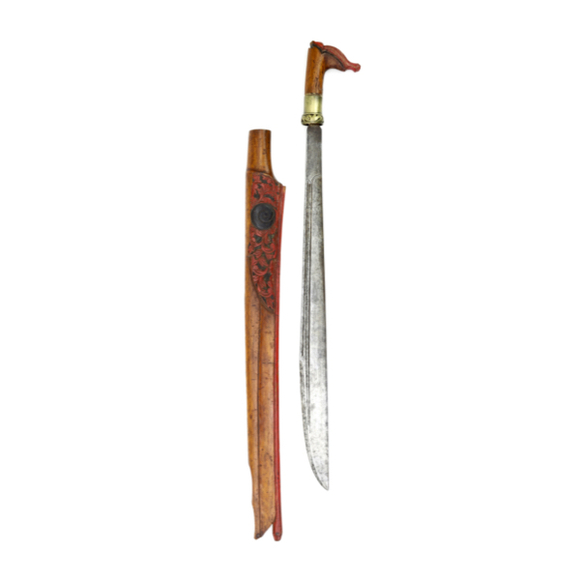Language: Indonesian
Source: Period sources
Description
The piso raout is a utility knife used throughout Borneo. Piso literally means "knife" and raout means "rattan". Apart from splitting rattan, it was used for numerous tasks as a utility knife. It was also used to carve the designs on hilts and scabbards of the Dayak headhunter swords.1

An oversized piso raout.
Mandarin Mansion inventory, 2022.
It consists of a small knife blade on a long handle. The knife can be held between the fingers for precision while the long handle can be put under the armpit for extra strength. It usually comes with blades about 5 to 10 cm long, but oversized examples with blades up to 13.5 cm are known.2 The blades are typically convex on the right side and slightly concave on the left side, a grind that we also see on Dayak headhunter swords.

A Kenyah mandau with its piso raout.
Sold by Mandarin Mansion in 2020.
Other names for it are:
Iban Dayak: Lunggat
Ngaju: Langgei
Dayaks of Barangan: Jabang
The long handle is called haut nyu by the Mendalam Kayan.
Notes
1. Albert G. van Zonneveld; Traditionele wapens van Borneo, de uitrusting van de koppensnellers. Deel III, zwaarden en messen. Sunfield Publishing, 2021. Page 233.
2. See an oversized example listed at mandarinmansion.com.
In period writings
On describing the Punan people:
"Even in the case of illness they rely upon their own skill rather than adopt the remedies employed by their neighbours - though in this respect, perhaps, the Dyaks could teach them little that is worth learning. One day one of the Poonans staying at Long Wai fell ill, and complained of a pain in his back. Without hesitation the chief took his small knife from his mandau sheath, and taking a piece of flesh firmly between his fingers made three incisions in the lower part of the back, in the region of the kidneys. In each slit he inserted a bamboo cylinder, two inches long, which he first made very hot, pressing them down firmly, and afterwards apply- ing a little hot water to the wounds, I felt this novel kind of seton, and found the three pieces of bamboo were fastened very securely into the flesh." 1
-Carl Alfred de Bock, 1882
"The handle or hilt is generally made of deerhorn, sometimes of ironwood, and is highly ornamented with scrolls and ingenious and symmetrical designs of animals, trees, monsters, etc. The only instrument used for the purpose is a broad sharp-pointed knife - means which seem quite inadequate to the end attained, for many of these carvings would do credit to a skilled English workman (Plate 18, Figs. 1, 2, 3, 4)." 2
-Carl Alfred de Bock, 1882

Plate 18
"On the under side of the sheath is a receptacle made of bark, carrying a small knife (see Plate 18, Fig. 2), the blade of which is three and a half inches, and the handle twelve inches, in length. This knife is used by the Dyak for severing the heads of the victims that fall to his man dan, and removing from them the fleshy parts; also for skinning animals killed in the chase; and in the more peaceful work of carving the ornaments which adorn his mandau, etc." 3
-Carl Alfred de Bock, 1882
Notes to period writings
1. Carl Alfred de Bock; Head-hunters of Borneo: a narrative of travel up the Mahakkam and down the Barito; also, Journeyings in Sumatra. London, S. Low, Marston, Searle & Rivington. 1882. Page 75.
2. Ibid, page 192.
3. Ibid, page 193.






